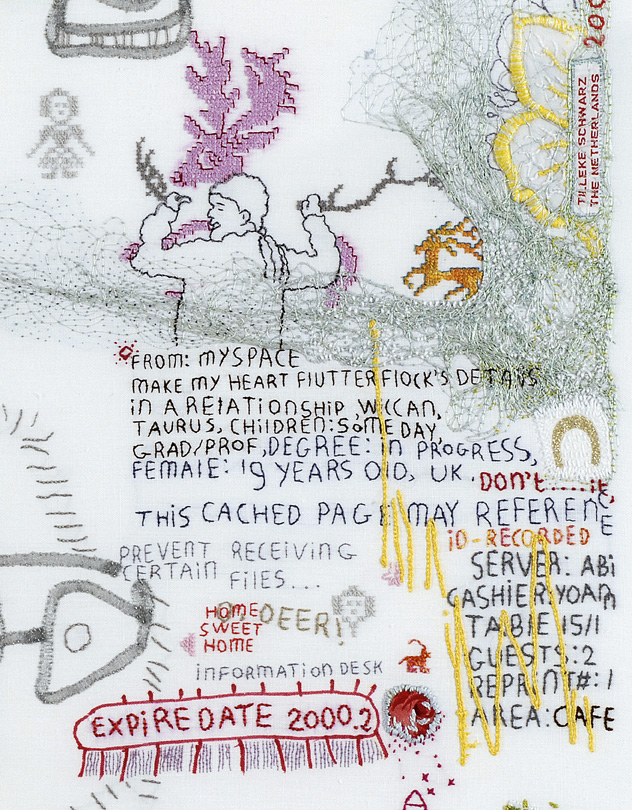I found this quite hard. Simone asked me to talk through my sampler.
She asked me to photocopy the sampler and give a written explanation of what it was all about - I think this was for final assessment. I had planned to do an artist statement, but feel that if it needs this much explanation, I've rather lost the plot in the working.
I had left in the central tacking line by mistake, but Simone recommended leaving it in. She queried the colours (purple and green on white - suffragette colours) and why I had chosen blue for the alphabet at the top (a dark enough colour, that I felt was fairly neutral). She asked who the two stitched figures were (both me, but actually me standing slightly in front of someone who I was representing) and why the quotations were in the same colour as the figure behind. As a dyslexic, she associated the colour of the script with the colour of the figure, which was not my intention. I had not thought about making the script the same colour as the person speaking, so agree this could be misleading. I had copious green thread, and limited purple, so had done the larger amount of stitch in green, and lesser amount in purple, then used the darker colour (purple) for the script when I realised I had enough thread to do it.
Simone advised me to go to CAA to look at a needle cushion. Possibly by an artist with initials LG. I looked on their website, and the only work that might involves needle in a cushion is Michael Brennand Wood. I know his work quite well and it leaves me cold. I loathe it and I hope I am not expected to be inspired by it.
Simone considered the framework of a sampler, and asked me to think about how to do it differently. Perhaps to work like an undergrad - and experiment with non-traditional ways of working. I just don't want to do this. I'm not wanting to work with discordant colour, different scales, ragged edges etc. She suggested looking at people who worked samplers in a less precise or unconventional way - which I have already done - Tilleke Schwartz. Except I don't want to work like Tilleke Schwartz.
 |
| Tilleke Schwartz |
She liked the image pushing the boundary, but wondered why it remained within the edge of the hem. It could have gone to the edge of the fabric, or not been hemmed. I loathe the idea of a raw edge, and equally feel uncomfortable with the stitched arms of the figure being effectively cut off if wrapped round the edge of the hem. I think Simone felt it was not a good self portrait as the imagery does not reflect how she sees me ... but this is irrelevant to me ... it's a self portrait, so it's about how I see me, not others. I think she felt I was working, clearly within a boundary, so the term pushing a boundary was inappropriate. But the way I see it, is that although the imagery I have used is about things I have done that have pushed my boundaries, in the greater scheme of things, it's small beer. I went to Australia to study, having never lived abroad before, and took on a different style of education. But it was fully supported by another university, I did not study abroad in a country where I would need to speak a foreign language, and I had my husband with me. Compared to incoming students at London Met and Herts, and political migrants in general, what I did, although it pushed my boundaries, was minor.
Simone wanted me to work onto tracing paper before I started the next sampler. More radicalness of pushing boundaries. More 'what if' questions.
I suppose what I am trying to do, is portray women in a way that changes the narrative from the patriarchal male imaginary, to my definition of the female imaginary. I'm using the traditional format of stitch and the sampler to juxtapose different female imaginaries.




